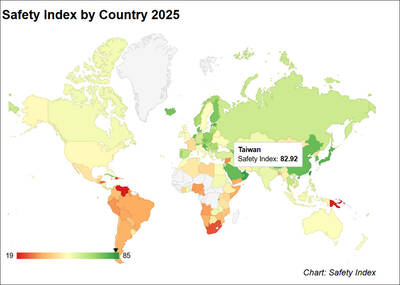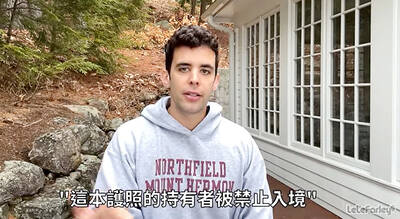While President Ma Ying-jeou (馬英九) has reiterated that the so-called “1992 consensus” was reached by Taiwan and China in 1992 to the effect that each side recognizes “one China, with each side having its own interpretation,” US cables recently released by WikiLeaks show that Chinese officials and academics clearly have a different understanding on what constitutes the “consensus.”
Both the Ma administration and China have stated that the consensus has been and should remain the foundation of cross-strait relations and dialogue.
In a cable dated Dec. 11, 2007, then-Chinese Nationalist Party (KMT) presidential candidate Ma told visiting American Institute in Taiwan Chairman Raymond Burghardt that the “one China, different interpretations” rubric of the consensus would be the key to any dialogue with China, adding that the KMT would reassure Beijing that its interpretation of the consensus is “steadfastly opposed to [Taiwan] independence.”
As recently as a press conference on Aug. 28, Ma said that despite the fact that no concrete results were reached during the cross-strait negotiations in 1992, both sides agreed that each side could have its own interpretation of “one China,” adding that while the term “1992 consensus” was indeed coined later, the idea of “one China, with each side having its own interpretation” did exist.
However, according to a leaked US cable dated Dec. 24, 2008, Taiwan Affairs Office Minister Wang Yi (王毅) mentioned “different interpretations” when the Chinese official discussed cross-strait relations with then-US ambassador to China Clark Randt.
“Both sides now accept and recognize the 1992 consensus, which means that both sides essentially accept there is only one China,” Wang was quoted as telling Randt, adding that in order “to solve [Taiwan’s] international space problem, the two sides must stick to the one China framework, because the improvement in cross-strait relations thus far has been on the basis of the one China principle.”
The international community accepts the “one China consensus” and UN-affiliated organizations also legally accept one China, therefore on the international stage “the rules are set and [they] cannot be changed,” Wang was quoted by the cable as saying.
Chinese academics expressed similar views in another cable dated March 21, 2008, issued by the US embassy in Beijing.
Zhou Zhihuai (周志懷), vice president of the Chinese Academy of Social Sciences’ Institute of Taiwan Studies, was quoted in the cable as saying that the consensus is flawed because “there is too much wiggle room for interpretation and because the Taiwan position of ‘each with its own interpretation’ is tantamount to [an] acceptance of two Chinas.”
While both sides want to improve relations, Zhou said, neither side has much room to make concessions.
The cable also quoted Sun Shengliang (孫盛良), director of the same institute’s economics department, as saying the “consensus was basically invented by KMT scholar Su Chi (蘇起).”
The cable showed Randt making a side note that it was the first time his embassy had heard the Chinese acknowledge this point.
In a recent forum held in Taipei, Taiwanese academics highlighted the different views on the “1992 consensus” held by officials in Taipei and Beijing, with Lo Chih-cheng (羅致政), a political scientist at Soochow University, saying: “China never talks about the 1992 consensus without mentioning its opposition to Taiwan independence.”
Tung Cheng-yuan (童振源), a professor at National Chengchi University said at the same forum that the real consensus between the Ma administration and Beijing was a “recognition of the one China principle” and “opposition to Taiwan independence.”

ENDEAVOR MANTA: The ship is programmed to automatically return to its designated home port and would self-destruct if seized by another party The Endeavor Manta, Taiwan’s first military-specification uncrewed surface vehicle (USV) tailor-made to operate in the Taiwan Strait in a bid to bolster the nation’s asymmetric combat capabilities made its first appearance at Kaohsiung’s Singda Harbor yesterday. Taking inspiration from Ukraine’s navy, which is using USVs to force Russia’s Black Sea fleet to take shelter within its own ports, CSBC Taiwan (台灣國際造船) established a research and development unit on USVs last year, CSBC chairman Huang Cheng-hung (黃正弘) said. With the exception of the satellite guidance system and the outboard motors — which were purchased from foreign companies that were not affiliated with Chinese-funded

PERMIT REVOKED: The influencer at a news conference said the National Immigration Agency was infringing on human rights and persecuting Chinese spouses Chinese influencer “Yaya in Taiwan” (亞亞在台灣) yesterday evening voluntarily left Taiwan, despite saying yesterday morning that she had “no intention” of leaving after her residence permit was revoked over her comments on Taiwan being “unified” with China by military force. The Ministry of the Interior yesterday had said that it could forcibly deport the influencer at midnight, but was considering taking a more flexible approach and beginning procedures this morning. The influencer, whose given name is Liu Zhenya (劉振亞), departed on a 8:45pm flight from Taipei International Airport (Songshan airport) to Fuzhou, China. Liu held a news conference at the airport at 7pm,

Taiwan was ranked the fourth-safest country in the world with a score of 82.9, trailing only Andorra, the United Arab Emirates and Qatar in Numbeo’s Safety Index by Country report. Taiwan’s score improved by 0.1 points compared with last year’s mid-year report, which had Taiwan fourth with a score of 82.8. However, both scores were lower than in last year’s first review, when Taiwan scored 83.3, and are a long way from when Taiwan was named the second-safest country in the world in 2021, scoring 84.8. Taiwan ranked higher than Singapore in ninth with a score of 77.4 and Japan in 10th with

Authorities yesterday elaborated on the rules governing Employment Gold Cards after a US cardholder was barred from entering Taiwan for six years after working without a permit during a 2023 visit. American YouTuber LeLe Farley was barred after already being approved for an Employment Gold Card, he said in a video published on his channel on Saturday. Farley, who has more than 420,000 subscribers on his YouTube channel, was approved for his Gold Card last month, but was told at a check-in counter at the Los Angeles International Airport that he could not enter Taiwan. That was because he previously participated in two